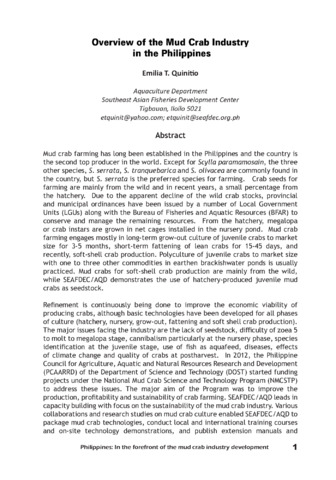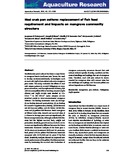Development of protocol for the production of hatchery-reared mud crab Scylla serrata juveniles for soft-shell crab farming
| dc.contributor.author | Quinitio, Emilia T. | |
| dc.contributor.author | Libunao, Gardel Xyza | |
| dc.contributor.author | Parado-Estepa, Fe D. | |
| dc.contributor.editor | Quinitio, Emilia T. | |
| dc.contributor.editor | Parado-Estepa, Fe Dolores | |
| dc.contributor.editor | Coloso, Relicardo M. | |
| dc.date.accessioned | 2017-08-25T09:08:57Z | |
| dc.date.accessioned | 2017-08-25T16:34:52Z | |
| dc.date.available | 2017-08-25T09:08:57Z | |
| dc.date.available | 2017-08-25T16:34:52Z | |
| dc.date.issued | 2017 | |
| dc.identifier.citation | Quinitio, E. T., Libunao, G. X., & Parado-Estepa, F. D. (2017). Development of protocol for the production of hatchery-reared mud crab Scylla serrata juveniles for soft-shell crab farming. In E. T. Quinitio, F. D. Parado-Estepa, & R. M. Coloso (Eds.), Philippines : In the forefront of the mud crab industry development : proceedings of the 1st National Mud Crab Congress, 16-18 November 2015, Iloilo City, Philippines (pp. 28-38). Tigbauan, Iloilo, Philippines: Aquaculture Department, Southeast Asian Fisheries Development Center. | en |
| dc.identifier.isbn | 9789719931072 | |
| dc.identifier.uri | http://hdl.handle.net/10862/3192 | |
| dc.description.abstract | Development of economically viable techniques for growing hatchery-reared juvenile crabs to suitable sizes will address the problem on the source of seed stocks for soft-shell crab farming. This paper reports the production of hatchery-reared mud crab Scylla serrata from juveniles in the nursery to 73-106 g body weight (BW) crabs in the grow-out pond for the individual system soft-shell crab farming. Likewise, the performance of hatchery-reared S. serrata, and wild S. tranquebarica and S. olivacea juveniles was determined in the soft-shell crab production set-up. The BW increased from 1.8-1.9 g to 78-113.7 g when stocked at 0.5 ind m-2 and from 1.6-2.3 g to 73-106.7 g at 1.0 ind m-2 after 75 days. Growth rates at both stocking densities were comparable. However, survival was significantly higher (P<0.05) in lower (63.6~c1.01%) than in higher (35.6~c3.34%) stocking density. Male S. serrata (46.0 ~c 1.75%) had significantly higher BW increase than females (39.4 ~c 2.05%). Crabs stocked at sizes of 51-60 g showed significantly greater percent increase in BW (43.26~c 0.98%) compared with those at 61-70 g (40.98~c1.33%), 71-80 g (38.55~c 1.04%), 81-90 g (36.34 ~c 1.27%) and 91-100 g (38.52 ~c 1.67%). Among the three species, hatchery-reared S. serrata (42.14 ~c 1.34%) had significantly higher mean percent BW increase compared with S. olivacea (38.23 ~c 0.49%) and S. tranquebarica (36.16 ~c 0.78%). S. serrata had significantly shorter mean culture period (24.11 ~c 0.95 days) than S. tranquebarica (28.48 ~c 0.54 days) and S. olivacea (28.75 ~c 0.34 days). | en |
| dc.language.iso | en | en |
| dc.publisher | Aquaculture Department, Southeast Asian Fisheries Development Center | en |
| dc.subject | Scylla olivacea | en |
| dc.subject | Scylla serrata | en |
| dc.subject | Scylla tranquebarica | en |
| dc.subject | Philippines | en |
| dc.title | Development of protocol for the production of hatchery-reared mud crab Scylla serrata juveniles for soft-shell crab farming | en |
| dc.type | Conference paper | en |
| dc.citation.spage | 28 | |
| dc.citation.epage | 38 | |
| dc.citation.conferenceTitle | Philippines : In the forefront of the mud crab industry development : proceedings of the 1st National Mud Crab Congress, 16-18 November 2015, Iloilo City, Philippines | en |
| dc.subject.asfa | aquaculture | en |
| dc.subject.asfa | brackishwater aquaculture | en |
| dc.subject.asfa | crab culture | en |
| dc.subject.asfa | growing ponds | en |
| dc.subject.asfa | growth rate | en |
| dc.subject.asfa | harvesting | en |
| dc.subject.asfa | hatcheries | en |
| dc.subject.asfa | marine crustaceans | en |
| dc.subject.asfa | nursery ponds | en |
| dc.subject.asfa | pond culture | en |
| dc.subject.asfa | seed production | en |
| dc.subject.asfa | stocking density | en |
| dc.subject.asfa | survival | en |
| dc.subject.asfa | trade | en |
| dc.subject.scientificName | Scylla serrata | en |
Files in this item
| Files | Size | Format | View |
|---|---|---|---|
|
There are no files associated with this item. |
|||
This item appears in the following Collection(s)
-
Philippines : In the forefront of the mud crab industry development [44]
Proceedings of the 1st National Mud Crab Congress



